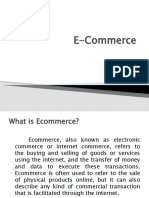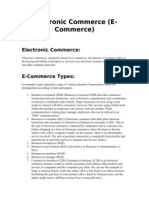0% found this document useful (0 votes)
4 views10 pagesE Commerce (Introduction)
E-commerce refers to the buying and selling of goods and services over the internet, revolutionizing business operations and creating new opportunities for consumers and entrepreneurs. It includes various models such as B2C, B2B, C2C, and C2B, and offers advantages like convenience, global reach, and cost-effectiveness, while also presenting challenges such as security risks and the need for reliable technology. E-business, a broader concept, encompasses all online business processes and has evolved significantly since its inception, impacting various industries and requiring businesses to adapt to digital transformations.
Uploaded by
triptamehmi135Copyright
© © All Rights Reserved
We take content rights seriously. If you suspect this is your content, claim it here.
Available Formats
Download as DOCX, PDF, TXT or read online on Scribd
0% found this document useful (0 votes)
4 views10 pagesE Commerce (Introduction)
E-commerce refers to the buying and selling of goods and services over the internet, revolutionizing business operations and creating new opportunities for consumers and entrepreneurs. It includes various models such as B2C, B2B, C2C, and C2B, and offers advantages like convenience, global reach, and cost-effectiveness, while also presenting challenges such as security risks and the need for reliable technology. E-business, a broader concept, encompasses all online business processes and has evolved significantly since its inception, impacting various industries and requiring businesses to adapt to digital transformations.
Uploaded by
triptamehmi135Copyright
© © All Rights Reserved
We take content rights seriously. If you suspect this is your content, claim it here.
Available Formats
Download as DOCX, PDF, TXT or read online on Scribd
/ 10






















































































